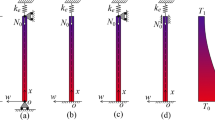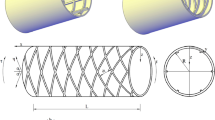Abstract
This paper is concerned with a numerical solution of hyperbolic cooling tower shell, a class of full nonlinear problems in solid mechanics of considerable interest in engineering applications. In this analysis, the post-buckling analysis of cooling tower shell with discrete fixed support and under the action of wind loads and dead load is studied. The influences of ring-stiffener on instability load are also discussed. In addition, a new solution procedure for nonlinear problems which is the combination of load increment iteration with modified R-C are- length method is suggested. Finally, some conclusions having important significance for practice engineering are given.
Similar content being viewed by others
References
Mang, H.A., et al., Finite element instability analysis of hyperbolic cooling towers,Advances in Civil Engineering Through Engineering Mechanics, New York, ASCE (1977), 246–249.
Chan, A.S.L., et al., Cooling tower supporting columns and reinforced rings in small and large displacement analysis,Comput. Meth. Appl. Mech. Engrg.,13 (1978), 1–26.
Abel, J.F., et al., Buckling of cooling towers,J. Struct., Div., ASCE,108 (1982), 2162–2174.
Abel, J.F., et al., Comparison of complete and simplified elastic buckling loads for cooling tower shells, IASS-RUB (1984), 309–318.
Mungan, I., et al., Nonlinear behaviour of cooling tower shells, IASS-RUB (1984), 298–307.
Mang, H.A., et al., Physically linear buckling analysis of reinforced concrete cooling towers—Design necessity or academic excercise?, IASS-RUB (1984), 279–297.
Dulacska, E., Buckling of reinforced concrete cooling tower shells, IASS-RUB (1984), 239–252.
Loo Wen-da and Li Long-yuan, Dynamic analyses of nonhomogeneous elastic hyperbolic cooling towers,J. of Shanghai Mech., 2 (1987). (in Chinese)
Brebbia, C.A.,Finite Element Systems. A handbook, A Comput. Mechanics Centre Publication (1982).
Thomas, G.R., et al., A triangular element based on generalized potential energy concepts,Finite Elements for Thin Shells and Curved Members, Chapter 9, Edited by D.G. Ashwell and R.H. Gallagher. Wiley (1976).
Dhatt, D.G., An efficient triangular shell element,AIAA, J.,18 (1970).
Dovey, H.H., Extension of three-dimensional analysis to shell structures using the finite element idealization. Ph. D. Dissertation, Univ. of California, Berkeley, UC-SESM Report No. 74-2, Jan.(1974).
Bergan, P.G., et al.. Solution techniques for nonlinear finite element problems,Int. J. for Numerical Methods in Engrg.,12 (1978). 1677–1696.
Crisfield, M.A., A fast incremental/iterative solution procedure that handles snap-through,Comput. and Struct.,13 (1983), 55–62.
Ahmad, S., et al., Analysis of thick and thin shell structures by curved finite elements.Int. J. for Numerical Methods in Engrg.,2 (1970).
Sabir, and Lock. The application of finite elements to the large deflection geometrically nonlinear behaviour of cylindrical shells.Variational Methods in Engineering, ed. C.A. Brebbia and H. Tottenham. Southampton Univ. Press (1973), 7–67.
Author information
Authors and Affiliations
Additional information
The Project Supported by National Natural Science Foundation of China.
Rights and permissions
About this article
Cite this article
Long-yuan, L., Wen-da, L. Nonlinear buckling analysis of hyperbolic cooling tower shell with ring-stiffeners. Appl Math Mech 10, 113–118 (1989). https://doi.org/10.1007/BF02014817
Received:
Issue Date:
DOI: https://doi.org/10.1007/BF02014817




